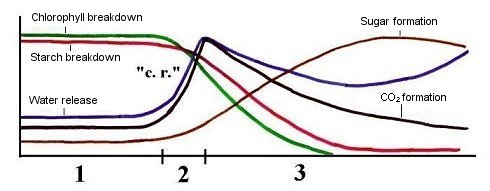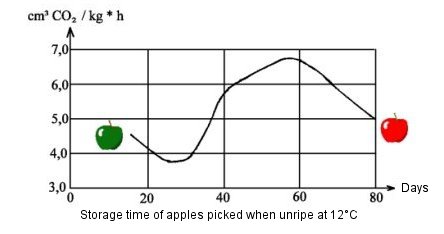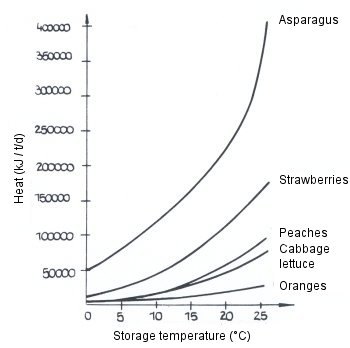Untreated fruit and vegetables are living organisms in which metabolic processes continue after harvest. The most important metabolic process is respiration, during which oxygen is absorbed from the air and carbon dioxide, water vapor and heat are excreted.
This proceeds according to the equation:
C6H12O6 + 6 O2 => 6 CO2 + 6 H2O + 2,826 kJ
These products of respiration have to be removed from the container by ventilation. The heat which is released (see kJ in the equation) is known as heat of respiration. The respiration intensity of goods of vegetable origin is dependent on the type, quality and degree of ripeness of the fruit, storage temperature, water content and air composition.

| Figure 79: Ripening of bananas 1 - preclimacteric (green) 2 - climacteric (turners) 3 - postclimacteric (yellow) "c.r." - "climacteric rise" |
According to Fig. 79, the respiration intensity of bananas, for example, starts at a minimum level, then increases rapidly and intensively to a maximum, after which it drops until the bananas die of old age. This last increase in carbon dioxide excretion, known as the "climacteric rise", marks the beginning of maturation of the fruit.

| Figure 80: Respiration curve for ripening apples [29] |
Fig. 80 shows a respiration curve for ripening applies, which likewise starts at a minimum, then rises rapidly to a maximum, which, as here, may sometimes be twice the minimum, after which it falls away. The heat evolved by the fruit is known as respiration heat. When transporting fruit in a refrigerated container, it is essential to chill it as quickly as possible by heat extraction, so as to reduce the evolution of respiration heat.

| Figure 81: Respiration heat produced by fruit and vegetables [1] |
Evolution of heat is particularly temperature-dependent (see Fig. 81): the higher is the temperature, the more intensive is respiration and the greater is the amount of heat released. Chilling is the most effective method of limiting respiration intensity and thus nutrient loss.
Respiration intensity generally reduces to between half and a third when the temperature is lowered by 10°C , i.e. the storage life can be doubled or even trebled by lowering the temperature by 10°C (see Arrhenius equation).
Anaerobic respiration (alcoholic fermentation):
If the refrigeration fails or ventilation is poor, respiration intensity may fall to 12 vol.% due to a drop in oxygen content and rise in carbon dioxide content of the ambient air, thereby resulting in a risk of anaerobic respiration, leading to the end products ethanol and carbon dioxide:
C6H12O6 => 2 C2H5OH + 2 CO2 + 117.2 kJ
Fermentation products may cause an entire container cargo of citrus fruits, for example, to begin fermentation within just a few hours. When a refrigerated container containing goods of vegetable origin is opened, there is not as a rule any danger of asphyxiation due to the build up of carbon dioxide or to oxygen consumption, since the CO2 (gas), which is heavier than air immediately "flows out" of the container "like water" when the container doors are opened. The space left by it fills up with ambient air, so that there is no danger when entering the container.